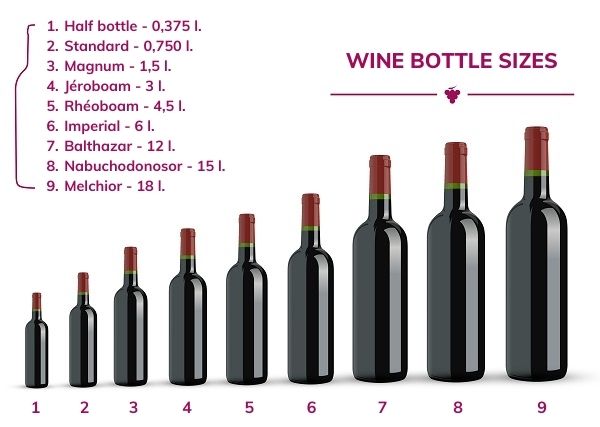Should I use a decanter for this wine?
Who hasn't wondered at some point if they should use a decanter with a wine?

In case there was any doubt... yes, in this article we are going to talk about the size of wine bottles, what else? Because you've probably never wondered but there are now more than a dozen different sizes of wine containers. Apart from the standard bottles (0.750 l), the fact that a winery decides to bottle part of its production in one or another format is not only a question of cost or commercial vision, since size can also affect the wine's storage potential, as we shall see.
Before we go any further, let's review the most common formats which, depending on whether they are for still or sparkling wines, may have slightly different names:

There are at least three other sizes, but they are very rare to find: Sovereign (25 l),which would be equivalent to 33 bottles and a third; Primat (25 l), which would be like the contents of 36 bottles (3 cases); and Melchizedek (30 l), the equivalent of 40 bottles of wine.
The answer is yes, and not only because of a question of cost, since it is cheaper to buy, for example, a Double Magnum than 4 standard bottles. The main argument for buying a larger bottle is that the larger the bottle, the better the wine will evolve and the longer it will age. This is because the contact of the liquid with the glass - which is exposed to light, heat, etc. - is proportionally less than that of a 0.750 l bottle, as is the entry of oxygen through the cork. Both factors contribute to the wine being preserved in good conditions for a longer period of time.
The list of names given to these bottles will surely have caught your attention, since most of them belong to kings mentioned in the Holy Scriptures. However, to this day there is no clear explanation as to why these names were used to name the different sizes of wine bottles. Could it be due to the greater or lesser importance of each of these monarchs in their time?
Who hasn't wondered at some point if they should use a decanter with a wine?
Excitement and hope in the Marco de Jerez region over the creation of a new designation of origin for traditional wines, seeking to attract young consumers with a sustainable and quality approach, projected for Europe in 2025.
At Peñín we are already focusing on the 2025 Guide, which begins its tasting tour this January to reach October with the most complete Guide to Spanish wines in the world.